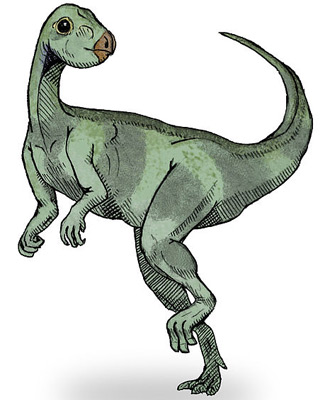
|
Search JoyZine with Google Site Search! |
Qantassaurus
Qantassaurus is is a genus of two-legged, plant-eating ornithischian dinosaur that lived about 115 million years ago, during the late Aptian/early Albian age of the early Cretaceous period. At the time, Australia was part of the supercontinent of Gondwana, and partly within the Antarctic Circle, although the significance of polar conditions during the warm Cretaceous were greatly different to conditions in this region today. The average temperature of the region is contentious, with estimates ranging from -6 to well over 5°C. Conditions were likely to be at their coldest during the polar nights, which lasted up to three months. Southern Victoria during the Early Cretaceous was a rift valley formed between Australia and Antarctica as the two continents slowly split apart. Braided streams and rivers formed extensive floodplains. Large fossilized logs found along the southern Victorian coast suggest nearby forests of araucarian conifers and podocarps. Deciduous ginkgoes were also important forest trees. The understorey would have included pentoxylaeans, ferns, bryophytes and mosses, and horsetails and reeds would have lined the streambanks. Victoria lay south of the palaeo-Antarctic Circle in the Cretaceous and, although the global climate was much warmer than it is today, the area would have experienced the extremes of daylight typical of polar regions. Evidence for rafting ice in the inland Eromanga Sea and studies of cryoturbation structures (deformations in sediments caused by the seasonal freezing and thawing of soils) suggest that the climate may at times have been quite cold, with winter ice and seasonally frozen ground. However, the presence of lungfish and crocodilians, now known only from warmer regions, suggests a generally milder climate. Qantassaurus was discovered on 27 February 1996, during the third annual field season of the Dinosaur Dreaming project, a dig jointly run by Monash University and the National Museum of Victoria. The dig occurs on the beach of the Bunurong Marine Park at the intertidal site known as Flat Rocks, near Inverloch, in south-eastern Victoria. The rock outcrops at this site are part of the Wonthaggi Formation of the Strzelecki Group, which during the Aptian stage were deposited in floodplains with braided river channels. The holotype specimen, NMV P199075, a 56mm-long single left dentary of the lower jaw, containing ten teeth (three unerupted), was found by Mrs Nicole Evered, a long time participant of the dig. It was named Qantassaurus intrepidus by Patricia Vickers-Rich and Tom Rich, in honor of the Queensland and Northern Territory Air Service, which shipped fossils around the country as part of the Great Russian Dinosaurs Exhibit between 1993 and 1996, and sponsored expeditions to South America and Eastern Europe. Qantassaurus is known from jaw fragments, these are foreshortened compared to related species, so its face was probably short and stubby. It had ten teeth in each lower jaw. It probably had a beak, and possessed leaf-shaped teeth back in its cheek, which were shed as they wore down, and replaced by new teeth growing up from the jaw. The teeth had eight distinctive vertical ridges on the outer side with a single larger primary ridge in the centre. It was probably about 1.8m long, and about 1m high. If it resembled its relatives, it had short thighs and long shins, and probably was a fast runner. Its feet had claws for traction, and a long tail probably helped with turning, stiffened by ossified tendons. One characteristic of the "Polar Victorian" euornithopods are distinctive spurs, or trochanters, on the upper surface of the thigh bone, where muscle was attached. Qantassaurus was part of a diverse assemblage of small Australian ornithopods that might have been part of the Australian dinosaur fauna since the Jurassic. Small ornithopods were remarkably common and diverse in Cretaceous Australia, particularly in southern Victoria, and may have travelled in small herds or flocks. Dinosaur burrows, possibly those of small ornithopods, were recently discovered along the southern Victorian coast. Perhaps Qantassaurus and other small ornithopods spent the colder months of the year underground. One interpretation of the fossil material is that small euornithopods had adaptations to survive cooler conditions. Bone growth of presumed related taxa shows they were active all year round, so they did not hibernate through the winter. The structure of these bones also suggests warm-bloodedness, which would help maintain its body heat. Qantassaurus was unique in that it had an unusually short (foreshortened) lower jaw. The teeth of Qantassaurus are almost impossible to distinguish from those of another small Victorian ornithopod, Atlascopcosaurus loadsi, although the jaw of Atlascopcosaurus is long, as in other ornithopods. Similarities to the teeth of Gasparinasaura from the Late Cretaceous of Argentina have also been noted. The jaw form and teeth of Qantassaurus are unlike those of Leaellynasaura amicagraphica, the smallest of the Victorian ornithopods. The maxillary teeth of Qantassaurus and Atlascopcosaurus both have at least eight ridges developed on unworn teeth, with a prominent primary ridge; Leaellynasaura has only five ridges on its cheek teeth, and a prominent primary ridge is absent. |
